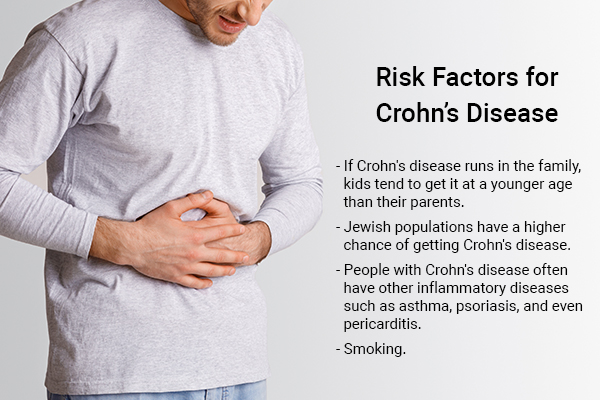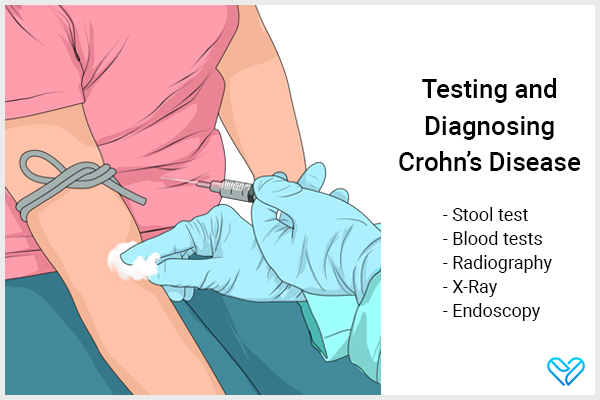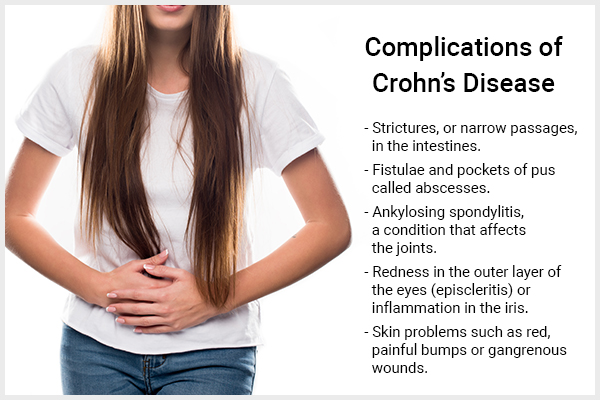In this article:
Crohn’s disease, also known as regional enteritis, granulomatous ileitis, or ileocolitis, is a type of inflammatory bowel disease that can cause damage to the gut. It attacks the digestive system and causes all sorts of digestive problems.

Basically, in Crohn’s disease, your immune system is unable to differentiate your own cells and starts attacking your intestines.
The inflammation caused by Crohn’s disease can affect any part of your digestive tract, from your mouth to your rectum. It can make you feel sick, cause severe pain and diarrhea, and even lead to malnutrition. (1)
Unfortunately, there’s no cure for Crohn’s disease. But with the right treatment, you can manage the symptoms and live a relatively normal life.
You may experience periods of remission where you feel great, but other times the symptoms may flare up. (1)(2)
The good news is that there are many different treatment options available, such as medication, lifestyle changes, and even surgery. And with the right care, you can improve your quality of life and keep the condition under control.
Read on to learn more about Crohn’s disease in detail.
Causes of Crohn’s Disease
Causes of Crohn’s disease include:
- Immune system dysfunction: In Crohn’s disease, the immune system mistakenly attacks the cells of the digestive tract instead of protecting them.
- Genetic factors: Crohn’s disease can run in families, indicating a genetic predisposition to the condition. Certain genes increase the risk of developing Crohn’s disease. One example is the NOD2/CARD15 gene, which can make the disease more severe if it has specific mutations.
- Environmental factors: Various environmental factors can contribute to the development of Crohn’s disease. These include certain medications, toxins, infections, and the composition of the gut microbiome (the community of microbes in the intestines). (1)(2)
- Gut microbiome changes: Changes in the gut microbiome, which consists of bacteria and viruses in the intestines, may play a role in Crohn’s disease. Gut bacteria metabolize nitrogen to produce substances they need to thrive. (3)
Note: While stress and certain foods do not cause Crohn’s disease, they can worsen symptoms in individuals who already have the condition. (4)
Symptoms of Crohn’s Disease
Symptoms of Crohn’s disease include: (2)(5)
- Chronic diarrhea, which means having loose and watery stools for more than 4 weeks
- Blood or mucus in the stool (6)
- Abdominal pain
- Losing weight unintentionally
- Skin rashes, joint pain, and eye inflammation
- Excessive thirst
- Pain or redness in the eyes
- Anemia (6)
Risk Factors of Crohn’s Disease

Several factors may contribute to the development of Crohn’s disease, and the chances of getting it can vary between different places. (2)
- Crohn’s disease usually hits people in their 30s. In Canada and New Zealand, women have a 10%–30% higher chance of getting Crohn’s disease, while in Japan and Korea, it’s the opposite – men are up to three times more likely to get Crohn’s disease.
- If Crohn’s disease runs in the family, kids tend to get it at a younger age than their parents.
- Jewish populations have a higher chance of getting Crohn’s disease.
- People with Crohn’s disease often have other inflammatory diseases such as asthma, psoriasis, and even pericarditis.
- Smoking, for example, can influence how Crohn’s disease behaves, worsening the condition. (7)
- A history of mumps may increase the chances of getting Crohn’s disease.
- Eating lots of fatty foods, meats, and certain types of fatty acids can up the risk of Crohn’s disease.
- Women taking oral contraceptive pills (OCP) have a slightly higher risk of developing Crohn’s disease.
Treatment for Crohn’s Disease
The traditional approach to treating Crohn’s disease is to start with mild drugs and gradually increase the intensity if needed. However, researchers suggest that aggressive treatment early on can lead to better outcomes, especially for people who have risk factors. (2)
The treatment options for Crohn’s disease are as follows:
- 5-ASA (mesalamine) is commonly used as a first-line treatment to reduce inflammation.
- Sometimes, antibiotics are used as a first-line treatment or for patients not responding to 5-ASA.
- Corticosteroids, budesonide, or mesalazine is used to calm the inflammation and bring about remission (lack of symptoms). (6)
- Loperamide or antispasmodic drugs can help with cramps and diarrhea.
- If the above-mentioned medications don’t work, immunosuppressive therapies are given, such as antitumor necrosis factor (TNF) treatments. (2)
- Another group of drugs called purine antimetabolites, such as azathioprine and 6-mercaptopurine, have been used for active Crohn’s disease, but their effectiveness is still debated.
- Some exciting new treatments, such as vedolizumab and ustekinumab, have emerged; they target specific molecules involved in inflammation. (2)(6)
- Metronidazole and ciprofloxacin as initial treatments for fistulas.
Note: It’s important to remember that taking these medications as prescribed and following your doctor’s advice is crucial. The success of Crohn’s disease management depends on your cooperation, and it’s okay to ask questions and learn about your condition. Surgery may be required if there is no prompt response to treatment.
Testing for and Diagnosing Crohn’s Disease

Several diagnostic tests are used to determine the existence of Crohn’s disease.
Stool test
Stool tests that check for infections include a culture and sensitivity test, ovum and parasite test, and Clostridium difficile toxin test. (1)(6)
Blood tests
Special blood tests can help distinguish Crohn’s disease from another similar condition called ulcerative colitis. (1)
Radiography
Sometimes, pictures are taken of your abdomen and pelvis to see what’s going on inside.
This can be done with a computed tomography (CT) scan or magnetic resonance enterography (MRE). These scans can detect abscesses (pus-filled pockets) and fistulas (abnormal connections between organs), among others. (1)(2)(6)
X-ray
If there’s a suspicion of bowel obstruction (things getting stuck), doctors might order plain X-rays. These can give them a better idea of what’s happening in the gut. (1)
Endoscopy
When regular cameras can’t reach certain areas, doctors might use video capsule endoscopy (VCE). It’s especially useful for checking the small bowel in Crohn’s disease. (1)(2)
Complications of Crohn’s Disease
Some complications that are associated with Crohn’s disease are: (1)(6)

- Strictures, or narrow passages, in the intestines
- Fistulae and pockets of pus called abscesses
- Ankylosing spondylitis, a condition that affects the joints
- Redness in the outer layer of the eyes (episcleritis) or inflammation in the iris (iritis) (6)
- Skin problems such as red, painful bumps (erythema nodosum) or gangrenous wounds (pyoderma gangrenosum)
- Kidney stones, also known as renal calculi
- Cholelithiasis (gallstones)
- A hypercoagulable state, which can make your blood thick and more likely to clot
Final Word
Crohn’s disease is a complex and chronic condition that affects the digestive system, causing a range of symptoms and challenges.
While there is no cure, proper management, including medication, lifestyle adjustments, and regular medical care, can help individuals with Crohn’s disease lead fulfilling lives and minimize the impact of the disease on their overall well-being.
 Continue Reading10 Home Remedies to Manage Crohn’s Disease
Continue Reading10 Home Remedies to Manage Crohn’s Disease
- Was this article helpful?
- YES, THANKS!NOT REALLY


